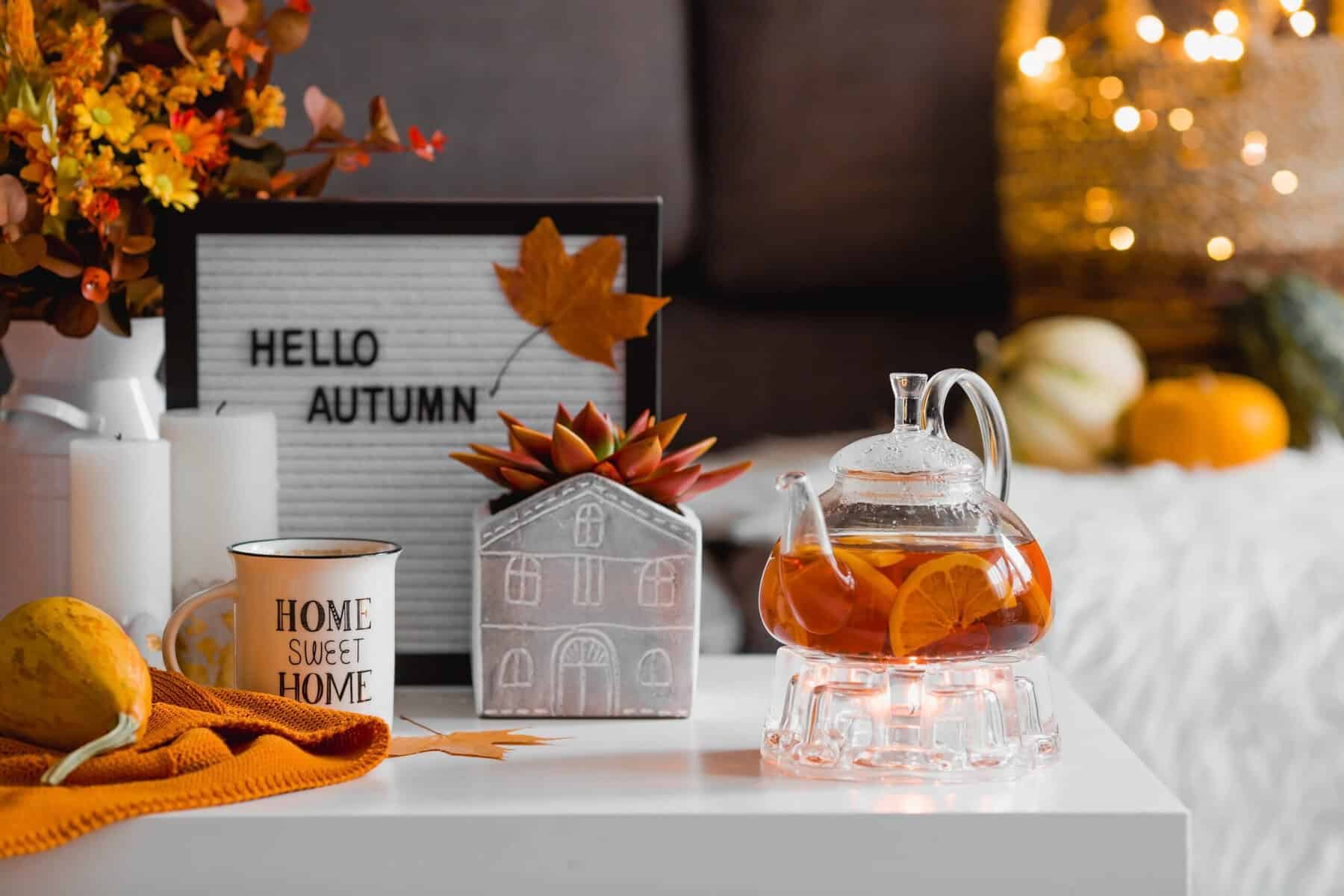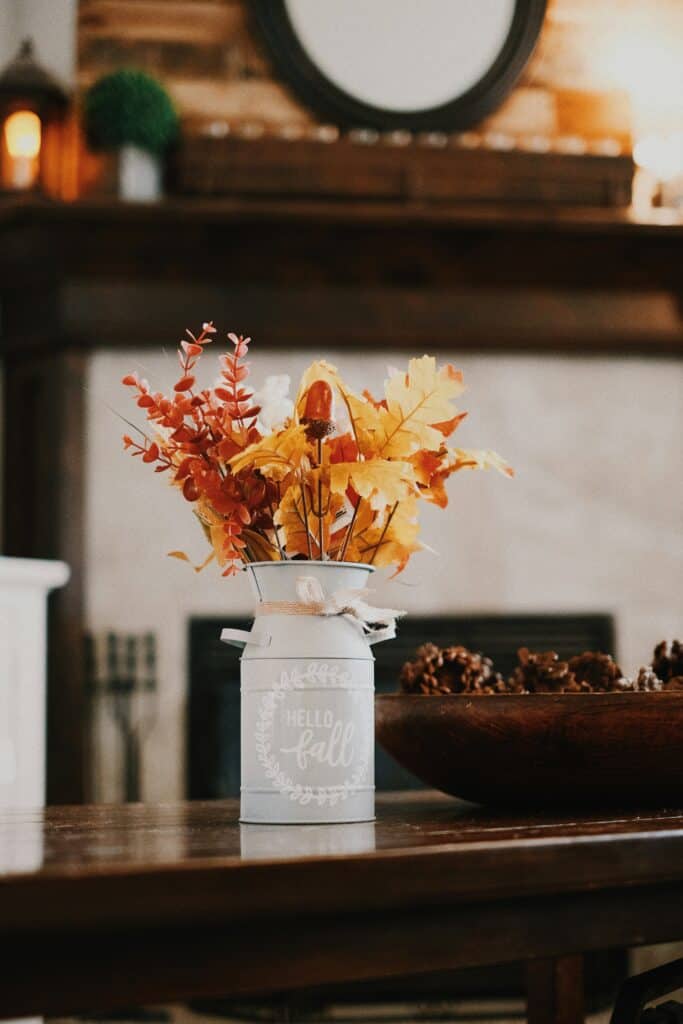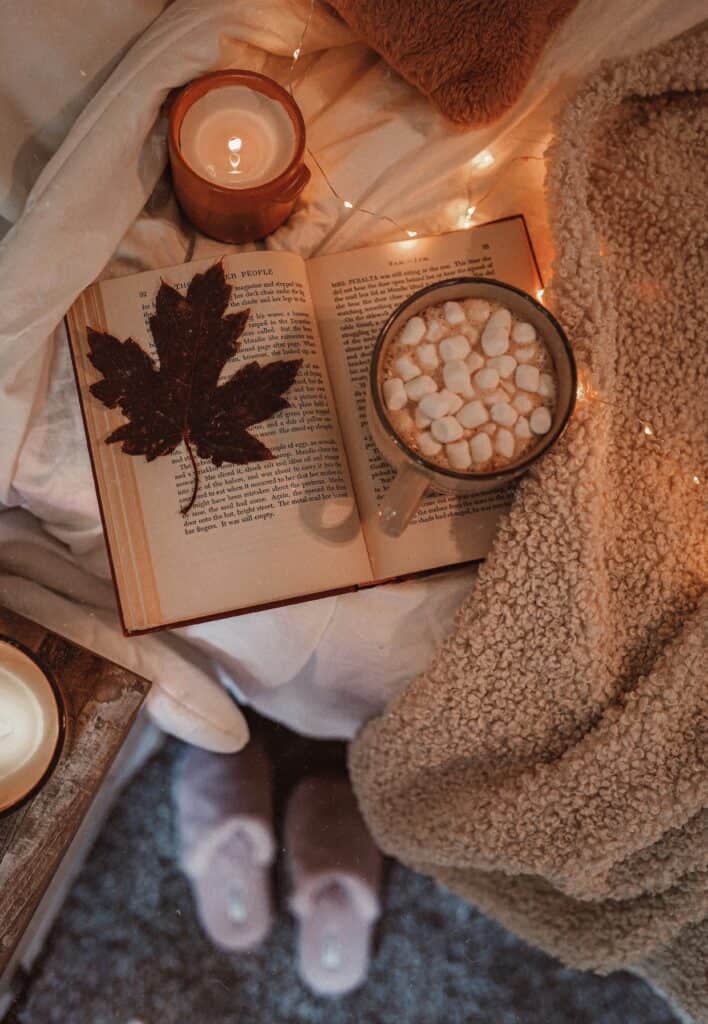Small Shifts, Big Comfort: Easy Autumn Decor for Wellness

Let’s be honest—we all have different feelings about autumn’s arrival. Maybe you’re like me and get genuinely excited when you spot the first changing leaf, already planning cosy evenings and pumpkin everything. Or perhaps you’re still mourning the end of summer, wishing you could hold onto those long, warm days just a little longer.
Wherever you fall on the autumn enthusiasm spectrum, there’s something we can all agree on: as the days get shorter and temperatures drop, our homes become more important than ever. We’re spending more time indoors, and that means our spaces need to work harder to support our mood, energy, and overall well-being.
The good news? You don’t need to completely redecorate or spend a fortune to create a home that feels like a warm hug. Sometimes the smallest changes make the biggest difference—like swapping out those bright white light bulbs for something warmer, or adding a chunky throw to your favourite chair. These little shifts can transform not just how your home looks, but how it makes you feel every single day.
Why Small Changes Pack Such a Big Punch
There’s real science behind why cosy environments make us feel better. Our brains are constantly reading our surroundings and sending signals to our bodies about whether we’re safe and relaxed, or stressed and on alert. Harsh lighting, cold surfaces, and stark spaces can keep us in a state of low-level stress, even when we’re trying to unwind at home.
But here’s where it gets interesting—when we surround ourselves with soft textures, warm lighting, and gentle scents, our stress hormones drop and our bodies shift into that “rest and digest” mode we all crave after a long day.
The beauty of focusing on small changes is that they don’t overwhelm you or your budget. You can try one thing, see how it feels, and build from there. No pressure, no rules—just small experiments in comfort.
Let There Be (Warm) Light

If I had to pick just one change that makes the biggest impact, it would be lighting. I’m talking about ditching those harsh overhead lights that make everyone look like they’re in a hospital waiting room.
Start simple: replace your regular LED bulbs with warm ones (look for 2700K or lower on the package). The difference is immediate—everything suddenly looks softer and more inviting. It’s like Instagram’s warm filter, but for real life.
Here are a few other lighting tweaks that cost almost nothing but change everything:
- Add a table lamp to that dark corner that’s been bugging you. Suddenly, it becomes a cosy reading spot instead of a dead zone.
- Get some battery-operated candles and put them on timers. All the ambience, none of the worry about forgetting to blow them out.
- Try string lights in unexpected places—behind your headboard, around a mirror, or even in a large plant. They’re not just for dorm rooms and holidays.
I’ve started following what I call the “6pm rule”—after 6pm, I turn off all the overhead lights and only use lamps and candles. It signals to my brain that the day is winding down, and I swear I sleep better because of it.
Texture Is Everything

You know that feeling when you walk into a fancy hotel lobby and just want to touch everything? That’s the power of good texture. Our sense of touch is directly connected to how safe and comfortable we feel, which is why a scratchy blanket can make you feel agitated while a soft one makes you want to curl up and stay awhile.
The easiest texture upgrade? Swap out your summer throws for something chunky and inviting. I’m talking about those thick, knit blankets that are almost too heavy but feel like a hug. Drape one over your couch or favourite chair, and watch how it becomes everyone’s preferred spot.
Other simple texture adds:
- A fluffy rug next to your bed so your feet hit something soft first thing in the morning
- Textured pillow covers in velvet, linen, or that trendy bouclé fabric
- Woven placemats or a nubby table runner that makes even Tuesday night dinner feel special
The goal is to have at least five different textures in each room. It sounds like a lot, but once you start noticing—wood, metal, fabric, ceramics, plants—you realise texture is everywhere.
Scent Without the Fuss

Smell is probably our most underrated sense when it comes to creating a cosy home. The right scent can instantly transport you to that feeling of “ahh, I’m home,” while the wrong one (looking at you, artificial air fresheners) can make you want to escape.
The good news is that autumn scent is easy and cheap to nail. Here are some of my favourite lazy-person aromatherapy tricks:
- Cinnamon sticks in a pretty bowl. They smell amazing for weeks and look intentional.
- Save your orange peels and put them near heating vents. As the warm air circulates, you get natural citrus aromatherapy.
- Eucalyptus branches from the grocery store in a tall vase. They’re like having a spa in your living room.
- Coffee beans in small dishes around your workspace. The smell is energising but not overwhelming.
For a quick room spray, mix water with a few drops of cedarwood and orange essential oils in a spray bottle. It smells like a cosy cabin without being too “scented candle store.”
Bringing the Outdoors In

Even if you’re not the most outdoorsy person, there’s something calming about having natural elements in your home. They remind us that we’re part of something bigger and bring a sense of life and movement to our spaces.
This doesn’t mean you need to become a plant parent overnight (though if you want to start small, pothos and snake plants are basically indestructible). Sometimes it’s as simple as:
- Collecting interesting branches on your dog walks and putting them in a tall vase
- Filling a clear jar with acorns or pinecones you find outside
- Pressing some pretty leaves between glass in simple frames
- Adding small succulents to windowsills where they’ll catch morning light
The key is choosing natural elements that don’t stress you out. If you kill every plant you touch, stick with branches and stones. If you love tending to green things, go for it. Your home should support you, not give you another thing to worry about.
Colour Therapy on a Budget
Colours have a real impact on how we feel, and autumn’s natural palette happens to be particularly good for our mental health. Warm oranges and reds energise without being overstimulating, while rich browns and deep greens help us feel grounded and stable.
You don’t need to repaint anything to get these benefits. Try adding colour through:
- Kitchen towels in terracotta or rust tones
- Throw pillows in deep forest green
- A golden yellow blanket that makes you smile every time you see it
- Burgundy candles for evening ambience
- Cream-colored lampshades that soften harsh light
Pick one colour that makes you feel good and add it to three different rooms through small accessories. You’ll be amazed at how this simple thread of continuity makes your whole home feel more intentional and pulled together.
Creating Tiny Sanctuaries

You don’t need a whole meditation room to create spaces that support your wellbeing. Sometimes, the most healing spots are tiny corners that serve one specific purpose really well.
Think about what you need most right now. Is it:
- A cosy reading corner? Add a side table, a good lamp, and a soft throw to any chair.
- A peaceful morning routine? Set up a tea station with your prettiest mug and favourite teas.
- Better sleep? Create a calming bedside setup with soft lighting and a few meaningful objects.
- More mindfulness? Designate a meditation spot with just a cushion, candle, and something beautiful to look at.
These micro-sanctuaries work because they’re specific. When you sit in your designated reading chair with your special blanket and perfect lighting, your brain gets the message: “Oh, this is relaxation time.”
Sound and Silence
We talk a lot about how spaces look and feel, but sound is just as important for creating a peaceful environment. The constant hum of traffic, appliances, and neighbour noise can keep us on edge without us even realising it.
Small sound improvements make a big difference:
- Wind chimes near your most-used door create gentle “mindfulness bells” throughout the day
- A small tabletop fountain masks jarring outside noise with soothing water sounds
- Soft background music (the same 15-20 songs on repeat) creates audio consistency that your nervous system learns to associate with home
- Thick curtains or area rugs absorb harsh sounds and create a sense of quiet sanctuary
Daily Rituals That Don’t Feel Like Work
The most powerful wellness practices are the ones that become so natural you don’t think about them. Build simple rituals around your comfort elements to maximise their impact:
Morning: Light a candle while making coffee. It’s such a small act, but it signals that you’re starting the day with intention.
Evening: Dim all your lights an hour before bed. This supports your natural circadian rhythms and helps your brain prepare for sleep.
Weekly: Rearrange one small area or swap accessories between rooms. It keeps your space feeling fresh without requiring a major overhaul.
Seasonally: Bring in fresh branches or seasonal elements from outside. It connects you to nature’s rhythms and keeps your home feeling alive.
You Don’t Need to Break the Bank
Creating a nurturing home doesn’t require a home design budget. Some of the most comforting elements cost less than your weekly grocery bill:
- Warm light bulbs: Under $15 and instant cosiness
- Thrift store throws and pillows: Unique textures at garage sale prices
- Battery tea lights: Safe ambience anywhere in your home
- Grocery store plants: Living energy that purifies your air
- Nature finds from your yard: Free seasonal beauty
- Cosy socks: Keep them in every room for instant comfort
The most expensive thing on this list might be a $20 throw from Target, and even that will transform how a space feels.
Start Where You Are
Here’s the thing about creating a cosy, healing home—it doesn’t happen overnight, and it shouldn’t. The spaces that nurture us best are the ones that evolve slowly, with each small addition building on the last.
Maybe you’re reading this and feeling excited about trying everything at once. Or maybe you’re overwhelmed and not sure where to start. Both reactions are completely normal. The key is to start with whatever feels most doable right now.
If you’re a summer person who’s still adjusting to shorter days, maybe begin with lighting changes that help brighten your mood. If you’re already autumn-obsessed like me, you might dive straight into those cosy textures and seasonal scents.
Trust your instincts about what comfort looks like for you. Some people need bold colours and lots of stimulation to feel energised. Others crave neutral tones and minimal decoration to feel calm. There’s no right or wrong way to make your home feel like a sanctuary—there’s just your way.
Your Comfort Zone Awaits
As the days get shorter and we spend more time indoors, your home becomes your most important tool for supporting your wellbeing. The small shifts you make now—that warmer light bulb, that soft throw, that candle lit with intention each morning—these aren’t just decorating choices. They’re investments in how you want to feel every day.
Whether you’re embracing autumn with open arms or grudgingly accepting that summer is over, you deserve a space that wraps you in comfort and supports your unique needs. The beautiful thing about focusing on small changes is that you can experiment, adjust, and build slowly toward a home that truly feels like your sanctuary.
So pick one thing—just one—that sounds appealing from everything we’ve talked about. Maybe it’s switching out those harsh light bulbs, or adding a cosy throw to your favourite spot, or lighting a candle with your morning coffee. Try it for a week and notice how it makes you feel.
Your autumn healing sanctuary is waiting, and it doesn’t require a complete makeover or a big budget. It just needs your attention to the small details that make a house feel like home.
What’s the first small comfort you’ll add to your space? Trust yourself—you already know what feels good.



